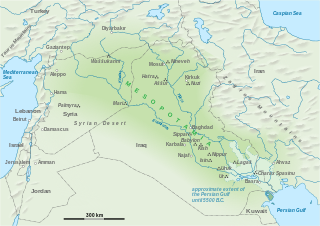
The Old Babylonian Empire, or First Babylonian Empire, is dated to c. 1894–1595 BC, and comes after the end of Sumerian power with the destruction of the Third Dynasty of Ur, and the subsequent Isin-Larsa period. The chronology of the first dynasty of Babylonia is debated; there is a Babylonian King List A and also a Babylonian King List B, with generally longer regnal lengths. In this chronology, the regnal years of List A are used due to their wide usage.

Sin-Muballit was the father of Hammurabi and the fifth Amorite king of the first dynasty of Babylonia, reigning c. 1813-1792 or 1748-1729 BC. He ruled over a relatively new and minor kingdom; however, he was the first ruler of Babylon to actually declare himself king of the city, and the first to expand the territory ruled by the city, and his son greatly expanded the Babylonian kingdom into the short lived Babylonian Empire.

The history of Mesopotamia ranges from the earliest human occupation in the Paleolithic period up to Late antiquity. This history is pieced together from evidence retrieved from archaeological excavations and, after the introduction of writing in the late 4th millennium BC, an increasing amount of historical sources. While in the Paleolithic and early Neolithic periods only parts of Upper Mesopotamia were occupied, the southern alluvium was settled during the late Neolithic period. Mesopotamia has been home to many of the oldest major civilizations, entering history from the Early Bronze Age, for which reason it is often called a cradle of civilization.
Kazalla or Kazallu (Ka-zal-luki) is the name given in Akkadian sources to a city in the ancient Near East whose locations is unknown. Its god is Numushda with his consort Namrat. There are indications that the god Lugal-awak also lived in Kazallu.

Naplanum was the first independent king of the ancient Near Eastern city-state of Larsa ca. 1961 BC to 1940 BC — roughly during the reign of Ibbi-Sin of the Third dynasty of Ur and the great famine — according to the later Larsa King List. No contemporary year names or inscriptions have been found verifying that Naplanum was a king of Larsa, which seems to have remained part of Ibbi-Sin's kingdom. However a prominent and wealthy Amorite merchant named Naplanum does appear in many sales records of the grain industry during these later days of the Third Dynasty, who may well have been the ancestor of the later independent kings of Larsa.
Emisum or Iemsium ruled the ancient Near East city-state of Larsa from 1940 BC to 1912 BC. He was an Amorite.
Samium ruled the ancient Near Eastern city-state of Larsa from 1912 BC to 1877 BC, according to the short chronology. He was an Amorite. He had a son called Zabaia.
Zabaia ruled the ancient Near East city-state of Larsa from 1877 BC to 1868 BC. He was an Amorite and the son of Samium.
Abisare ruled the ancient West Asian city-state of Larsa from 1841 BC to 1830 BC. He was an Amorite. The annals of his 11-year reign record that he smote Isin in his 9th regnal year.

Sumuel or Sumu-El ruled the ancient Near East city-state of Larsa from c. 1894 BC to 1866 BC. He was an Amorite.

Nur-Adad ruled the ancient Near East city-state of Larsa from 1801 BC to 1785 BC. He was a contemporary of Sumu-la-El of Babylon.

Sin-Iddinam ruled the ancient Near East city-state of Larsa from 1785 BC to 1778 BC. He was the son of Nur-Adad, with whom there may have been a short co-regency overlap.
Sin-Eribam ruled the ancient Near East Amorite city-state of Larsa for only two years, from c. 1778 BC to 1776 BC .
Sin-Iqisham ruled the ancient Near East city-state of Larsa from 1776 BC to 1771 BC. He was the son of Sin-Eribam and a contemporary of Zambiya of Isin.
Silli-Adad ruled the ancient Near East city-state of Larsa from 1771 BC to 1770 BC. His reign was less than a full year; the annals state that he was "removed from kingship" and "was no longer king". His successor was Warad-Sin.

Warad-Sin ruled the ancient Near East city-state of Larsa from 1770 BC to 1758 BC or 1834-1823. There are indications that his father Kudur-Mabuk was co-regent or at very least the power behind the throne. His sister En-ane-du was high priestess of the moon god in Ur.

Sîn-kāšid was the king of the ancient Mesopotamian city of Uruk during the first half of the 18th century BC. His precise dating is uncertain, perhaps ca. 1803–1770 BC corresponding to ca.1865–1833 BC, but likely to have been fairly long due to the voluminous building inscriptions extant for which he is best known and contemporary with Nur-Adad of Larsa and Enlil-bāni of Isin. His apparent lack of relationship with any of the preceding rulers of Uruk and his omission of mentioning his father in any of his inscriptions has led to the belief that he was the founder of a dynasty. He participated in a diplomatic marriage with Šallurtum, the daughter of Sūmû-la-Il, the second king of the First Babylonian Dynasty, as her name and epithets appear in the seal impressions of three clay bullae recovered from the remains of his palace.

Rim-Sîn I ruled the ancient Near East city-state of Larsa from 1758 BC to 1699 BC or 1822 BC to 1763 BC. His sister En-ane-du was high priestess of the moon god in Ur. Rim-Sin I was a contemporary of Hammurabi of Babylon and Irdanene of Uruk. He was of Elamite descent, notwithstanding his Akkadian name.
Rim-Sîn II ruled the ancient Near East city-state of Larsa from 1678 BC to 1674 BC. Rim-Sin II was a contemporary of Samsu-iluna of Babylon.
This page is based on this
Wikipedia article Text is available under the
CC BY-SA 4.0 license; additional terms may apply.
Images, videos and audio are available under their respective licenses.










